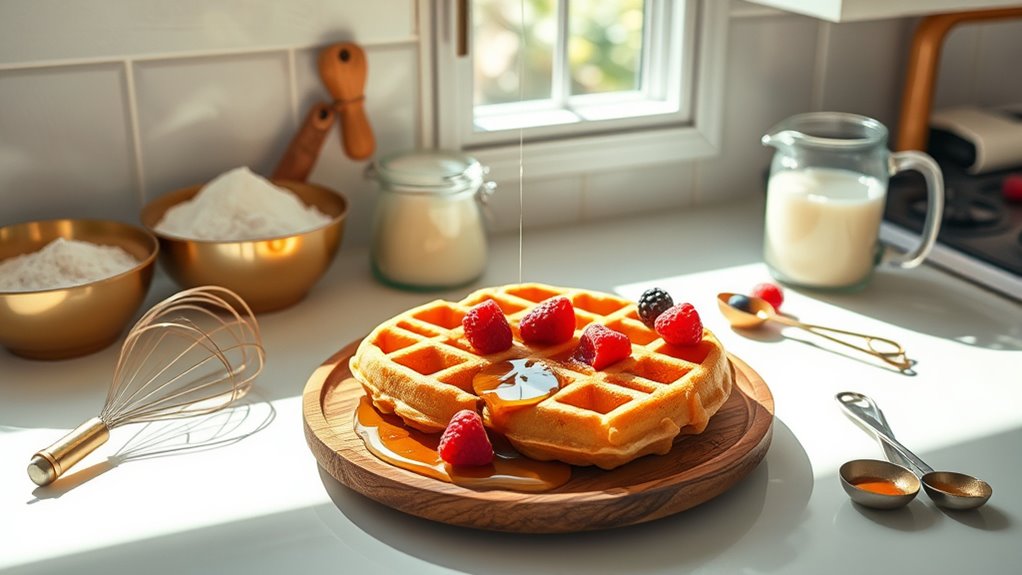To make perfect crunchy waffles, start by precisely measuring 2 cups of flour, 1 tbsp sugar, 1 tsp baking powder, ½ tsp baking soda, and ¼ tsp salt. Preheat your waffle iron thoroughly while mixing wet and dry ingredients gently to avoid toughness. Lightly grease the iron to prevent sticking. Pour batter carefully, close the iron without opening until done, and serve immediately on warm plates with light toppings. Master these steps, and you’ll reveal expert waffle-making secrets next.
Ingredients and Quantity
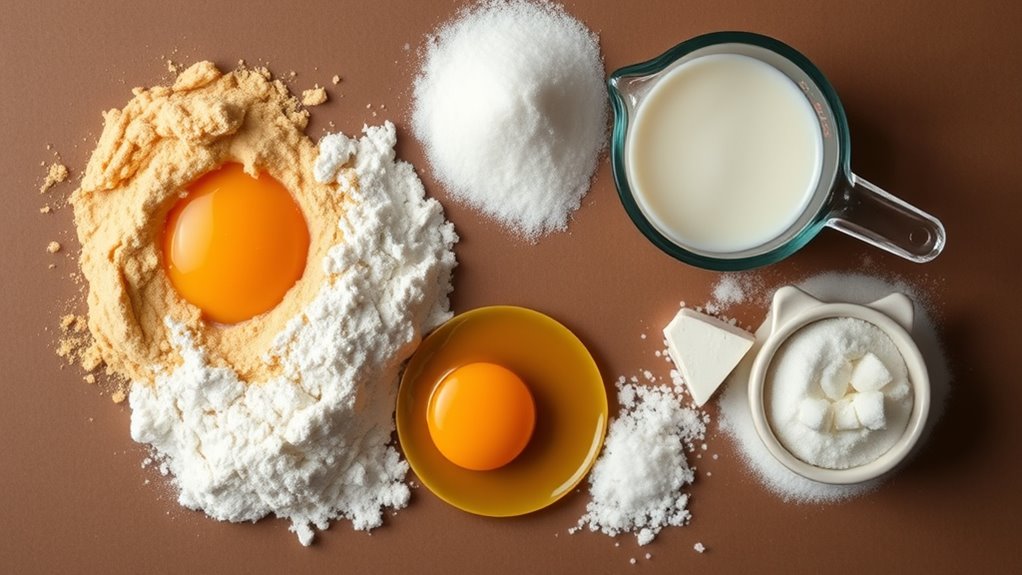
Before you begin mixing, gather all ingredients in exact quantities: 2 cups of all-purpose flour, 1 tablespoon of granulated sugar, 1 teaspoon of baking powder, 1/2 teaspoon of baking soda, 1/4 teaspoon of salt, 2 large eggs, 1 3/4 cups of buttermilk, 1/2 cup of melted unsalted butter, and 1 teaspoon of pure vanilla extract. Selecting the right flour types affects texture; all-purpose flour balances structure and tenderness. Sugar options like granulated sugar enhance crispness without overpowering sweetness.
| Ingredient | Quantity | Purpose |
|---|---|---|
| All-purpose flour | 2 cups | Base structure |
| Granulated sugar | 1 tbsp | Crispness and mild sweetness |
| Baking powder | 1 tsp | Leavening agent |
| Baking soda | 1/2 tsp | Reacts with buttermilk |
| Salt | 1/4 tsp | Flavor enhancer |
Preparations

Although gathering ingredients accurately is essential, properly preparing your workspace and equipment guarantees efficient mixing and cooking. Begin by ensuring your surfaces are clean and dry to prevent contamination or unwanted moisture affecting the waffle batter’s consistency. Pre-measure all ingredients, so you can execute precise cooking techniques without interruption. Next, preheat your waffle iron to the recommended temperature, allowing it to reach ideal heat for a crispy exterior. When mixing, use a whisk or electric mixer to combine wet and dry ingredients just until smooth; overmixing can toughen the batter. Finally, lightly grease the cooking surface to prevent sticking, ensuring even browning. These preparation steps form the foundation for achieving perfectly crunchy waffles that maintain a tender interior.
Tools / Kitchenware Required
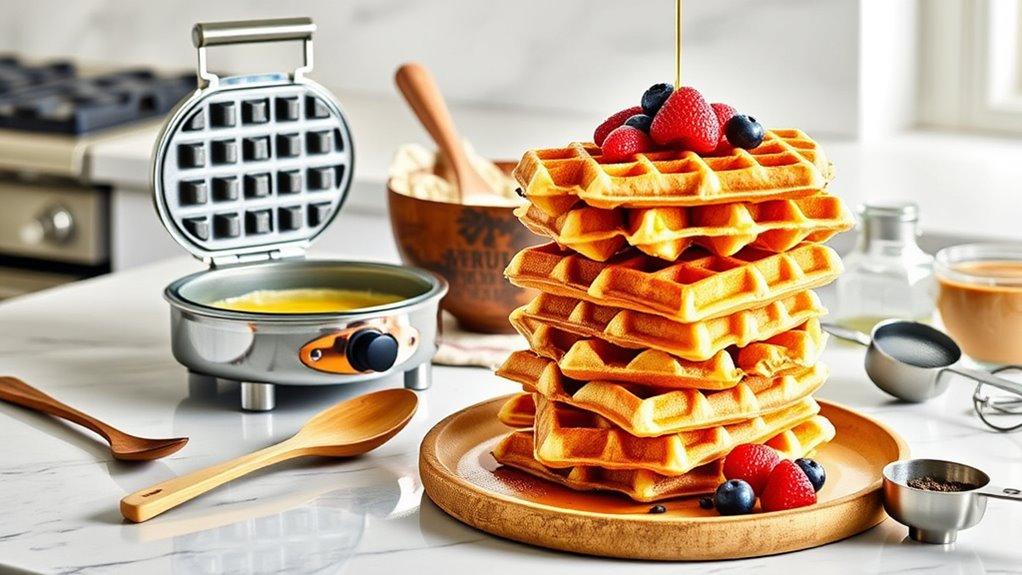
You’ll need a few essential tools to guarantee your crunchy waffles turn out perfectly every time. Start with a high-quality waffle iron—its temperature control and non-stick surface are vital for achieving that ideal crispness. A sturdy mixing bowl allows thorough blending of ingredients without spills. Precision scales secure exact measurements, while a silicone spatula aids in folding batter gently. Finally, a cooling rack lets waffles breathe, preserving crunch.
| Tool | Purpose | Key Feature |
|---|---|---|
| Waffle iron | Cooking waffles evenly | Adjustable temperature |
| Mixing bowl | Combining ingredients | Large, stable base |
| Precision scale | Accurate measurement | Digital readout |
| Silicone spatula | Gentle mixing and folding | Heat-resistant |
| Cooling rack | Maintaining waffle texture | Elevated airflow |
These tools empower you to create crisp, golden waffles with total freedom.
How to Cook
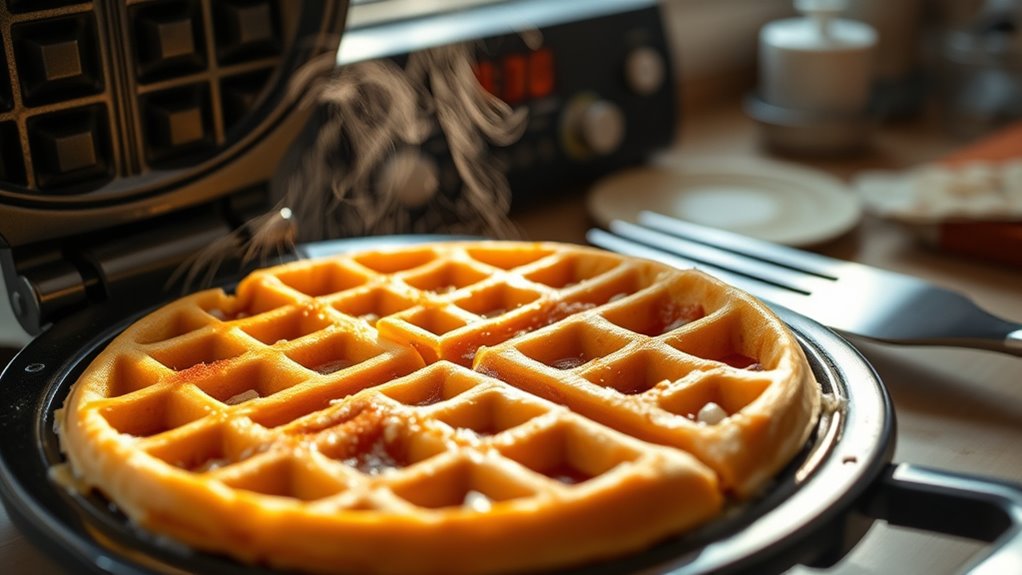
- Preheat your waffle iron to the recommended temperature.
- Carefully pour the batter onto the center of the plates, ensuring an even layer without overfilling.
- Close the iron firmly to distribute heat evenly.
- Avoid opening the iron during cooking to maintain crispness.
- Monitor cooking times closely to prevent undercooking (which causes sogginess) or overcooking (which causes burning).
- Adjust cooking time based on batter thickness and waffle iron model.
- Rotate or shift the iron if you notice uneven browning.
- Use a timer to standardize cooking times for consistent results.
How to Serve
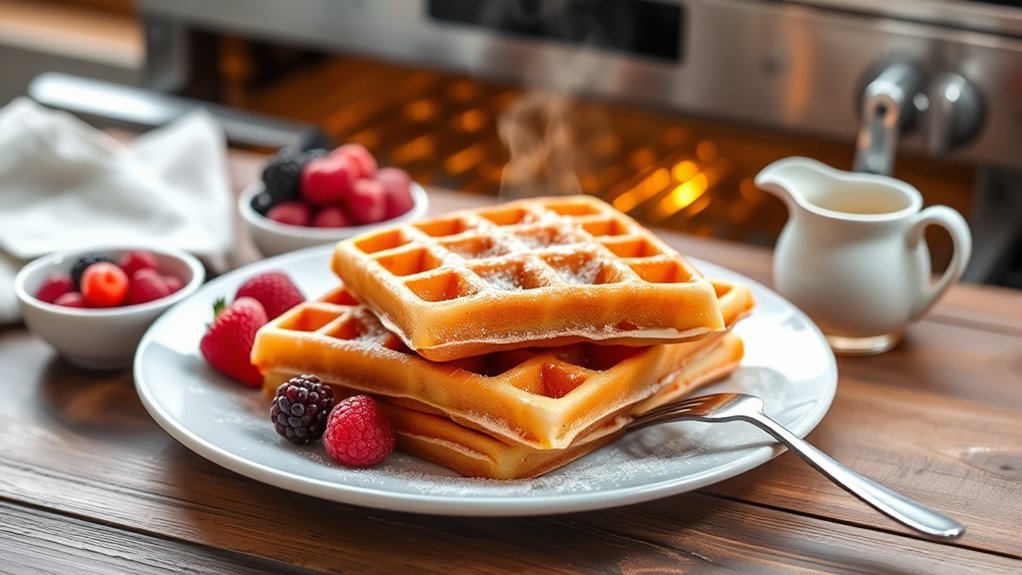
Three key factors determine how you serve your waffles to maximize their crunch and flavor: timing, temperature, and topping selection. Serve waffles immediately after cooking to retain ideal crispness; delays cause moisture absorption and sogginess. Maintain a warm serving environment, ideally between 140°F and 160°F, using a warming drawer or low oven to preserve texture without drying. Choose waffle toppings that complement but don’t overwhelm the waffle’s crisp exterior—light syrups, fresh fruit, or a dusting of powdered sugar work best. Avoid heavy, wet toppings that compromise crunch. For serving suggestions, arrange waffles on pre-warmed plates to sustain heat. Stack waffles sparingly to prevent steam buildup. By controlling these variables, you guarantee each bite delivers the perfect balance of crunch and flavor freedom, satisfying your craving precisely as intended.
Tips
Although achieving the perfect crunchy waffle requires attention to batter consistency and cooking temperature, mastering a few technical tips can greatly enhance your results. You’ll want to experiment with batter variations to find the ideal balance between moisture and crispness. Precision in heat control guarantees even cooking without burning. Don’t forget to customize your waffle toppings to complement the texture and flavor.
- Use a high-protein flour for added structure.
- Incorporate cornstarch to increase crispiness.
- Preheat the waffle iron fully before batter application.
- Avoid overmixing the batter to prevent toughness.
- Cool waffles on a wire rack to maintain crunch.
These strategies give you freedom to tailor your waffles perfectly every time.
Food Value and Benefit
Waffles made with nutrient-dense ingredients offer a balanced source of energy by combining key macronutrients such as carbohydrates, proteins, and fats. Incorporating whole grain flours, eggs, and healthy fats enhances the overall nutritional profile of the dish.
Nutrient-rich waffles blend carbs, protein, and healthy fats for a balanced and energizing meal.
Food Value of Prepared Waffles:
- Rich in complex carbohydrates for sustained energy
- High-quality protein from eggs for muscle repair and growth
- Healthy fats from olive oil to support heart health and nutrient absorption
- Good source of dietary fiber when made with whole grain flours, promoting digestive health
- Contains essential vitamins and minerals such as:
- Vitamin B-complex (including B6 and folate) for energy metabolism
- Vitamin E from healthy oils, supporting antioxidant protection
- Minerals like iron, magnesium, and zinc from whole grains and eggs
- Calcium if dairy or fortified alternatives are used
Benefits of Eating This Recipe:
- Provides balanced energy to fuel daily activities
- Supports muscle health and repair through quality protein intake
- Enhances heart health with healthy fats
- Promotes digestive well-being due to increased fiber content
- Supports immune function and antioxidant defense with vitamins and minerals
- Suitable for various dietary needs when customized (gluten-free, dairy-free options)
- Helps maintain stable blood sugar levels by moderating added sugars
Frequently Asked Questions
Can I Make Waffles Ahead and Reheat Them?
Yes, you can make ahead waffles and reheat them effectively. To maintain crunch, cool waffles completely on a wire rack before storing in an airtight container or freezer bag. When ready, reheat using a toaster or oven at 350°F for 5-7 minutes; avoid microwaves as they cause sogginess. These reheat tips preserve texture and flavor, giving you the freedom to enjoy crispy waffles anytime without compromising quality or taste.
What’s the Best Waffle Batter Consistency?
You want your batter thickness to be just right—about the consistency of heavy cream—to achieve ideal waffle fluffiness. Studies show that batter viscosity directly affects texture; too thin, and waffles turn soggy, too thick, and they become dense. Aim for a pourable yet slightly thick batter to allow steam to create air pockets during cooking, giving you that light, airy interior with a crispy exterior. Adjust flour and liquid ratios carefully for freedom in texture.
How Do I Store Leftover Waffles?
For ideal waffle storage, let your waffles cool completely, then stack them with parchment paper in between to prevent sticking. Store them in an airtight container or a resealable freezer bag to maintain crispness. When reheating, use a toaster or oven at 350°F for 3-5 minutes to restore crunch without sogginess. Avoid microwaving, as it makes waffles rubbery. This method keeps your waffles fresh and crispy, giving you freedom to enjoy them anytime.
Can I Freeze the Waffle Batter?
Think of your waffle batter as a delicate seed—freezing it can stunt its rise. Technically, you *can* freeze batter, but freezing tips suggest it may lose leavening power and texture, affecting crispness. For best batter storage, keep it refrigerated and use within 24 hours. If you must freeze, portion it airtight, thaw slowly in the fridge, then whisk gently before cooking. This preserves your freedom to prep ahead without sacrificing waffle quality.
Are There Gluten-Free Waffle Alternatives?
Yes, you can definitely make waffles using gluten free flour blends designed to mimic traditional wheat flour’s texture and binding properties. Look for blends containing rice flour, tapioca starch, and xanthan gum to achieve that perfect crispness. When choosing waffle toppings, opt for fresh fruits, nuts, or dairy-free yogurts to complement the gluten-free base, giving you freedom to enjoy varied textures and flavors without compromising your dietary needs.
